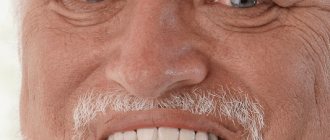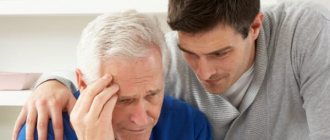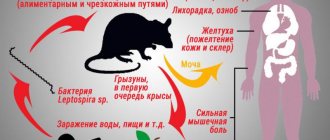Why does a person get old?
With age, the metabolic rate decreases significantly, therefore, due to the lack of protein, cells die, lipid metabolism is disrupted, and the amount of energy consumed by the body decreases.
After 40 years, the human reproductive system gradually loses its function, irreversible changes occur in all systems: endocrine, cardiovascular, respiratory, urinary, etc. Iron deficiency anemia often occurs, and the functioning of the liver glands involved in the neutralization of toxins decreases.
To a greater extent, changes occur in the immune system, since the immune function of proteins decreases, which contributes to the growth of infectious and inflammatory diseases, as well as tumor cells (normally, immune cells destroy tumor cells).
Unfortunately, many people in their young years neglect the recommendations of specialists to lead a healthy lifestyle, eat right, exercise and pay attention to health. This gives rise to habits that remain unchanged throughout life: overeating, alcohol and tobacco abuse, eating unhealthy foods, lack of physical activity. All this significantly increases the risk of changes in the musculoskeletal system and the occurrence of chronic pathologies.
Heredity is of no small importance in the aging process, since the body’s predisposition to certain pathological processes directly depends on genetics.
In most cases, chronic diseases in old age are characterized by a latent course, but at the same time with progression and the likelihood of partial or complete loss of function of certain organs. These are distinctive features of the disease in older people.
As a rule, men of retirement age suffer from diseases of the genitourinary system, prostate gland, and suffer from ischemic heart disease. Women often face type II diabetes mellitus, diseases of the skeletal system, and hypertension. In addition, men and women are susceptible to gastrointestinal diseases caused by digestive disorders, as well as inflammatory bowel processes.
Senile mental illnesses
The young body copes. The same cannot be said about older people. Over the years, the natural process of aging occurs.
It's no secret that all diseases are caused by nerves. The sooner you start taking care of yourself and your health, the higher your chances of living a long and happy life. The nervous system is one of the most complex, important, and at the same time fragile systems of the human body. Basic elements of the nervous system:
- Central (brain, spinal cord);
- Peripheral (neurons).
Classification of diseases of the nervous system:
- Infectious diseases are caused by exposure to viruses and other bacteria. The brain is the first to suffer.
- Traumatic. Diseases resulting from bruises and injuries.
- Hereditary.
Coronary heart disease (CHD)
The occurrence of this pathology is due to atherosclerotic damage to the walls of the arteries, which serve as a source of nutrition for the myocardium. Men over 50 years of age are more susceptible to this disease. The cause of IHD is due to factors such as:
- Burdened heredity.
- Lack of physical activity.
- Incorrect and inadequate nutrition.
Therefore, people whose relatives have a history of myocardial infarction or heart pain of various etiologies should, from a young age, minimize or eliminate high-calorie foods, which are the main source of cholesterol, from their diet. Moderate physical activity is also an excellent preventive measure for coronary artery disease.
Cholesterol is an organic compound that is necessary for metabolism and metabolism. Essentially, cholesterol is a polycyclic alcohol that is synthesized in the human liver. With regular consumption of high-calorie foods, as well as genetic predisposition, atherosclerotic plaques form on the walls of blood vessels.
The symptoms of this disease are one of the forms of coronary artery disease – angina pectoris (single or frequent pain in the heart, provoked by spasm of the arteries). This condition is caused by the fact that the heart muscle does not receive enough oxygen. If the attack lasts for a long time, part of the myocardium dies and a heart attack occurs. Immediately after the elderly person recovers, a characteristic connective tissue scar forms on the myocardium.
Any pain in the heart cannot be tolerated, therefore, in case of an attack of pain, medical assistance is required. In this case, a nitroglycerin tablet, which should be placed under the tongue, will quickly help. It is not recommended to take Corvalol and Validol. Next, you should seek emergency medical help.
Routine treatment for ischemic heart disease includes vasodilators, cholesterol-lowering drugs and a strict diet limiting foods of animal origin.
Nervous system diseases
Timely adoption of measures at an early stage of the disease can significantly extend the active period of life with this disease. In the last decade, drugs have appeared that, although they do not cure completely, can slow down the disease for several years. In addition, it has recently been proven that under certain conditions, nerve cells, including those of the brain, can be restored.
The incidence of Alzheimer's disease increases sharply after 65 years, ranging from 2-3% at the age of 75-80 years, to 12% at the age of 85-90 years. In people actively involved in mental work, the disease develops approximately 5 years later than in people who work physically.
The incidence of Alzheimer's disease in women is 1.5-3 times higher than in men. Alcoholism dramatically accelerates the development of the disease.
Arterial hypertension (AH)
Pathology such as hypertension in most cases occurs in elderly women. This is due to excess body weight, regular stress, and a history of various heart diseases. Characteristic signs of hypertension are headaches in the temporal or parietal part, increased blood pressure, chills, dizziness. If you do not monitor your blood pressure, cerebral circulation may be impaired, which will lead to to a stroke. This disease affects not only the blood vessels of the brain, but also the musculoskeletal system, vision, and hearing. A hemorrhagic stroke is accompanied by an extremely serious condition and often causes disability.
However, unpleasant sensations do not always arise with high numbers. Quite often, blood pressure is asymptomatic. Therefore, blood pressure monitoring should be regular.
If an elderly person has high blood pressure numbers, they should seek medical help for examination and diagnosis. Treatment is prescribed to the patient individually and includes taking medications on an ongoing basis, a diet with limited salt, foods high in calories, and, if necessary, weight loss.
Symptoms
Typically, neurosis in old age is manifested by increased irritability. Any non-standard situation can lead to emotional swings, anger, aggression, or, conversely, tearfulness. This already depends on the psycho-emotional type of person.
The main symptoms of neurosis:
- Sudden mood swings for no apparent reason.
- Increased excitability of the central nervous system.
- Manifestation of aggression.
- Closedness.
- Removal from society.
- Regular bad mood.
- Silence.
- Feeling of constant anxiety.
- Low self-esteem.
A person suffering from neuroses becomes very sensitive to temperature changes. His sleep is disturbed, he has poor appetite, and problems with short-term memory appear.
Also, against the background of constant strong emotional stress, a person’s vision may decrease or hearing may deteriorate.
Diabetes mellitus type II
Type II diabetes often occurs at retirement age. With this pathology, tissues do not absorb glucose and the patient experiences the following symptoms:
- Constant strong thirst.
- Dry skin.
- Frequent urination.
- Various infections (condition caused by decreased immune system function).
Diabetes mellitus is characterized by vascular damage, which leads to deterioration of vision (up to its complete loss), and decreased blood supply to the extremities.
If there is a high glucose content in the blood of a person suffering from diabetes, it is excreted during urination and the body, accordingly, loses water. Against this background, coma may develop.
To help the patient, the specialist prescribes medications that promote the absorption of glucose, a diet that excludes the consumption of baked goods and foods containing sugar, weight loss, and physical activity.
Aging of the nervous system
Very often, asthenia is accompanied by anxious hypochondria. Patients with depression often have a mild or even absent sad mood.
Depression with lethargy, adynamia, or depression with an affect of anxiety predominates. Usually there is no ideomotor inhibition, which suggests the predominance of mixed states.
Depression often occurs with irritability, grumpiness, and dissatisfaction. The content of depressive delusions is dominated by ideas of ruin, impoverishment, hypochondriacal character or ideas of self-abasement.
Important
Cotard's delirium is often observed, most often its hypochondriacal variant. In hypomanic and manic states, either unproductive efficiency or fussiness, or states with fragmentary expansive delirium (mania with pseudoparalytic syndrome) predominate.
Deterioration of hearing, vision
In old age, hearing and vision often decrease. This condition is caused by the development of irreversible dystrophic processes that develop in the cells responsible for their normal functioning. Most often, degenerative changes in the muscles of the eye and a change in the shape of the lens occur, which leads to the development of farsightedness. This pathology of eye refraction is corrected with glasses. In addition, older people often experience dry eyes. The problem is eliminated by prescribing appropriate treatment (eye drops).
In sensorineural hearing loss, the inner ear is severely affected. This reduces hearing and requires correction with a special hearing aid. In the absence of treatment, coordination of movements is impaired, so therapy should be prescribed in a timely manner.
Organic mental disorders in older people
Organic mental disorders are severe irreversible pathologies that arise as a result of dementia.
They can be grouped based on 3 criteria:
- Lacunar or total mental disorder. Totality affects all cognitive processes and affects all areas of mental activity. Lacunar captures one or two functions - thinking, memory, mood, perception.
- Is this process acute or chronic? The acute course begins suddenly, while the chronic course has a long, sluggish character.
- Brain dysfunction is focal or generalized. The first can be caused by a tumor, while the generalized one can arise, for example, as a result of increased intracranial pressure.
Dementia in older people usually comes on gradually. At first, the symptoms may not be noticeable, but in the future the symptoms will only worsen. With total dementia, a pensioner cannot perform the simplest tasks, they lose their personality, forget those around them and themselves, and cease to adequately evaluate their actions.
Lacunar dementia occurs with partial memory loss and impaired attention, i.e., the assessment of oneself as a person is preserved. There are different types of diseases that cause dementia.
Organic mental disorders
Senile dementia
Popularly, this disease is also called senile dementia. It appears as a result of atrophic processes that occur in the brain. Deviations in mental activity are divided into behavioral, emotional and cognitive.
Dementia is associated with many types of disorders, but is always closely associated with cognitive impairment. Against this background, the sick person feels depressed, he often develops causeless depression, and degradation begins.
The disease develops gradually. As a result of deterioration in mental activity, an elderly person forgets previously acquired skills and cannot master new knowledge.
Next, the personality begins to coarse, and senile qualities develop:
- stinginess;
- loss of interests;
- callousness;
- selfishness;
- bitterness;
- irritability.
His views on life turn from personal to stereotyped. Sometimes carelessness and complacency appear, a loss of moral skills and the acquisition of various forms of perversion are possible.
Short-term memory suffers; often, the patient does not remember yesterday, but enthusiastically describes pictures of the past. That is why he often finds himself in memories of himself as a young man.
The external form of the personality does not change, the usual forms of expression and gestures remain the same, so it is difficult for close people to suspect something is wrong, and against the background of antisocial behavior, conflicts arise.
Dementia is classified into 3 types:
- Atrophic. Due to diseases against the background of degenerative processes occurring in the cells of the central nervous system (Pick's disease, Alzheimer's disease).
- Vascular. Appears as a result of circulatory disorders in the vessels of the heart and brain (atherosclerosis, hypertension).
- Mixed. The mechanism of development of dementia is associated with both the vascular type and the atrophic type.
Diagnostics is carried out in the form of testing, during which certain tasks are set that need to be completed. Unfortunately, there is no specific treatment for dementia, so it is best to prevent this pathology.
Senile dementia
Alzheimer's disease
This is the most common cause of senile dementia. It is a neurodegenerative disease in which the destruction of nerve cells responsible for transmitting impulses between brain structures occurs.
Taken together, this causes memory impairment and a gradual loss of basic skills with the ability to self-service, a pronounced decline in intellectual capabilities with impaired ability to correctly and adequately understand the environment.
Attention: Alzheimer's disease can begin after 50 years of age, but most often it happens after 70, and especially after 80 years. This is even evidenced by statistical data, where between the ages of 65 and 75 only 4% of people suffer, and after 85 years already 30%.
The clinical severity of this disease is divided into stages.
So early signs in the stage of pre-dementia are:
- the ability to perform work that requires increased attention and concentration is gradually lost;
- the patient begins to forget minor things (whether he took medicine, where he went yesterday, etc.);
- mastering new information does not bring the desired success, because it does not stay in the head for a long time;
- it is difficult for an elderly person to plan something or concentrate on something;
- Taking care of himself is also a problem; he forgets to brush his teeth, clean up after himself, change clothes or wash himself.
These symptoms can last up to 8 years, after which early dementia sets in. In this case, it will no longer be possible to attribute the patient’s behavior to normal old age, since memory deterioration continues to progress.
It is short-term memory that suffers the most. Speech impairment, agnosia, apraxia, poor vocabulary, and weakened writing abilities may also appear. At this stage, the patient can still perform simple actions, but in a situation that requires complex cognitive tasks, he is absolutely helpless.
With moderate dementia, pronounced speech impairments are observed with a minimal vocabulary. In addition to short-term memory, long-term memory also begins to deteriorate.
At this stage, situations are possible when an elderly person ceases to recognize relatives and forgets many moments from his youth. The psycho-emotional disorder is only getting worse. Possible touchiness, irritability, and a tendency to wander. The concept of personal hygiene is alien, enuresis may appear.
With severe dementia, an elderly relative falls entirely on the shoulders of relatives, because he is absolutely helpless and needs care. Speech is almost lost, only individual phrases and words remain. Although aggression persists, more often the patient remains in an apathetic state without any emotions.
Alzheimer's disease
Pick's disease
This disease is progressive in nature with atrophy of the temporal and frontal lobes of the brain. The average age of onset of mental pathology is 50-60 years, and women suffer from the disease several times more often than men.
The reasons for the appearance have not yet been clarified, but several etiological factors are identified:
- hereditary nature;
- long-term intoxication of the body;
- previous mental illness;
- head injuries.
At the initial stages of this deviation, a decrease in thinking processes, a narrowing of inference, judgment and criticism is noticed.
The clinical picture looks like this:
- passivity, inactivity, indifference;
- loss of moral qualities;
- a sharp decrease in self-criticism, including criticism towards other people;
- the emergence of sexual liberation;
- bouts of euphoria;
- short-term mental abnormalities in the form of hallucinations, jealousy, delusions, psychomotor agitation, paranoid episodes);
- decreased ability to write, count and read;
- movement disorders (stiffness of movements, slowness).
An obligatory sign of Pick's disease is expressed in a focal disorder of the cerebral cortex, which means speech impairment, up to complete silence, vocabulary, grammatical and semantic impoverishment of speech, reluctance to talk, echolalia (repetition of heard words).
Pick's disease
Parkinson's disease
With Parkinson's disease, control of one's own movements is lost. This is due to degenerative processes in the extrapyramidal system of the brain, and, as a consequence, disruption of the transmission of nerve impulses.
The first signs of the disease appear 10-15 years after the onset of pathological changes and are expressed as follows:
- Hand shaking (tremor). It is reminiscent of counting coins, which does not stop even at rest, and with excitement the tremor only intensifies. Next, the shaking moves to the head (reminiscent of uncontrolled head movements like no-no, yes-yes).
- Amimia (mask-like face). This is due to a decrease in facial activity. Characteristic is both the slow onset of the emotion and the same belated extinction.
- Changes in handwriting and speech impairment. When speaking, one feels monotony and lack of expressiveness.
- Bradykinesia and hypokinesia. Due to a decrease in controlled activity, general stiffness of the body appears. The patient can remain in one position for up to several hours, and can be brought to his senses with a loud movement or sound. All movements performed are very slow and are performed with some delay.
- There are no synkinesis. The patient cannot make friendly movements; when walking, he does not swing his arms; they are pressed to the body.
- Kinesias are paradoxical. After waking up in the morning or experiencing pronounced emotional outbursts in an elderly person, the manifestations of motor disorders decrease, but after a few hours they still return.
- Waxy plastic flexibility. Increased muscle tone leads to a feeling of automatic movements. When bending or straightening the limbs, muscle tension is felt.
- Postural instability. In the later stages of the disease, it becomes more and more difficult to start movement, as well as to finish it.
- Violation of mental reactions. In this case, pathological fatigue, depression, insomnia predominate, memory decreases, and absent-mindedness increases.
Treatment of Parkinson's disease is mainly based on stopping degenerative processes in the brain. But even with such a favorable outcome, it is unlikely that it will be possible to restore lost motor functions.
Parkinson's disease
You cannot insure against such mental disorders, but you can try to prevent them through prevention. Don't leave your grandparents all alone and visit them as often as possible. Help me find hobbies and new entertainment. Ensure a dignified old age and always be present during any shocks.
Back and joint pain
Joint pain is caused by changes in cartilage tissue. As a result, diseases arise that contribute to changes in the osteoarticular system. The most common pathologies of the musculoskeletal system in older people are osteoarthritis and osteochondrosis.
Osteoarthritis is characterized by the destruction of cartilage (connective) tissue, which leads to symptoms such as:
- Pain with any activity (running, walking).
- Impaired joint mobility.
- Redness in the joint area.
One of the causes of osteoarthritis is excess weight. Reducing body weight by 10% will significantly alleviate a person’s condition.
With osteochondrosis, destruction of the intervertebral discs occurs, as a result of which the spinal nerves are injured and the following occurs:
- Pain in the lumbar, cervical and dorsal spine.
- Disorders of the function of some internal organs.
- Loss of spine flexibility (untreated).
First of all, the treatment of such pathologies involves weight loss, exercise therapy and massage that strengthens muscles. In addition, for moderate to severe pain, physical therapy or effective painkillers are prescribed.
What is an epileptic seizure?
An epileptic seizure is a short-term episode of abnormal excessive discharge of nerve cells in the cerebral cortex, causing a condition that is noticeable to the person having the seizure or to others around them.
Sometimes the patient may forget the attacks and not notice them. Likewise, seizures of epilepsy in patients may not always be noticeable to others. The clinical manifestations of attacks are very diverse in different patients and reflect the functions of those areas of the cortex in which the pathological discharge occurs and through which it spreads. Motor, sensory or mental disturbances, autonomic disorders and neurological symptoms of prolapse (such as cessation of speech or loss of muscle tone) may occur alone or in combination. Epileptic seizures often have a sudden onset and usually resolve spontaneously. They are usually short, lasting from a few seconds to a few minutes, and are often accompanied by a period of drowsiness or confusion (postictal period).
Despite the variety of seizures, a given patient usually experiences only one or a few types of seizures; Moreover, the attacks are usually similar to each other (their manifestations are stereotypical in each individual case) and are quite short-lived (lasting a few seconds or minutes). The variety of clinical manifestations of epileptic paroxysms was the basis for the development of their unified classification.
Epileptic seizures are always a sign of a pathological process, but not all seizures are manifestations of a chronic disease (epilepsy).
Memory loss, dementia
In old age, degenerative disorders of some parts of the brain often occur. This pathology is associated with serious changes in cerebral circulation, in which brain atrophy (decrease in volume) occurs. Such changes directly affect its function: memory deterioration, emotional background, ability to reason, form thoughts, which leads to dementia. One of the pathologies caused by impaired metabolism of protein compounds in brain cells is Alzheimer's disease. Treatment of this disease requires taking medications on an ongoing basis.
The development of motor skills (knitting, playing table tennis), moderate mental stress that promotes memory development (learning foreign languages, computer literacy, solving crosswords) will help slow down the development and subsequent progression of dementia. Drug treatment includes taking medications that improve blood circulation in the brain.
Regular communication is important for older people, since loneliness only contributes to the development of pathologies of the nervous system. To avoid many diseases in old age, it is necessary to lead an active lifestyle, eat right, maintain a normal body weight, and maintain immunity with the help of vitamin and mineral complexes.
In our boarding house, prevention of the main age-related ailments is regularly carried out.
Involutional mental changes in older people
Involutional mental disorders do not have an anatomical substrate, are reversible and, as a rule, do not lead to dementia, i.e., intellectual-mnestic functions remain preserved. Mental deviations of this register can begin at a young or mature age, and many patients live with them into old or senile age. This includes several types of mental disorders.
Senile neuroses
There are a huge number of causes of neuroses in old age. This may be dissatisfaction with one’s own life, severe physical exhaustion, the presence of feelings of guilt, retirement, hormonal disorders, a sharp deterioration in health, etc.
Symptoms of neuroses are manifested in the following:
- increased irritability;
- excitability and aggression;
- touchiness;
- decreased self-esteem;
- noise in ears;
- sudden mood swings;
- feeling of fear;
- anxiety;
- silence and reluctance to communicate with other people;
- frequent bad mood;
- problems with memory, hearing and vision;
- fear of loud sounds and bright lights;
- sleep disturbance;
- loss of appetite.
Treatment is carried out by a neurologist on an outpatient basis.
Neuroses
Depression
Depressive disorders are the most common mental disorders in old age. Approximately 30-40% of older people are diagnosed with this condition.
Many people consider depression a normal part of old age and do not pay attention to it. This opinion is erroneous, because such a long-term mental disorder gives rise to a tendency to commit suicide.
Depression occurs against the background of nervous overstrain, stress, somatic diseases, hormonal imbalance and is manifested by apathy, a sharp decrease in mood and physical activity, and negative thoughts. Regardless of the nature of the occurrence of depression in old age, it is characterized by a general pattern and feature that is difficult to diagnose.
So, at the age of 50-60 years, the characteristic symptoms of depressive syndromes are:
- anxious concerns;
- presence of anxiety;
- diffuse paranoidity;
- self-accusation;
- hypochondriacal fears.
From 70 years of age other signs appear:
- discontent;
- apathy;
- a feeling of resentment received undeservedly.
As a rule, people in old age do not have depressive self-flagellation and evaluation of the past. On the contrary, against the backdrop of a gloomy view of the present time, health, social status and financial situation, past events appear in a positive light.
Over the years, the sense of moral guilt is lost. Hypochondriacal fears about health, as well as thoughts about financial insolvency, begin to be expressed. Close people are accused of neglect, lack of service and attention, and lack of empathy.
Attention: depressive disorder is twice as common in women aged 50-60 years than in men of the same age category.
Depression in older people
Anxiety
Feeling anxious is a natural state at any age. An illness, a new meeting, problems in relationships cause anxiety and this is quite normal.
However, if this happens on a regular basis, it significantly impedes social connections and deteriorates health. About 20% of older people experience a constant feeling of anxiety and even phobia.
There are several forms of this mental disorder:
- Specific phobias . This is an intense fear of things or events that do not actually pose a big threat. For example, claustrophobia, fear of spiders or flying, death, accident, etc. Confrontation with the root cause of fear causes severe panic, and even pain in the sternum.
- General anxiety disorders . These older people have increased anxiety disorder. They panic over the slightest little things or far-fetched reasons. It is difficult for them to relax and unwind, and they have sleep disturbances.
- Social anxiety . Here, the feeling of anxiety manifests itself in social situations that the elderly person encounters on a daily basis. Some are embarrassed by their appearance, others find it difficult to ask a stranger for something or confuse their name when communicating.
- Obsessive-compulsive anxiety . This type of deviation is associated with the daily repetition of certain actions. For example, arranging objects in a certain order, performing the ritual of washing, and then reading a book, and only then breakfast. A feeling of anxiety appears if something is out of place, a mistake is made in a daily ritual, etc.
- Post-traumatic anxiety . A panic state is associated with a certain event that caused physical or moral harm to a person (road accidents, military events, natural disasters, robbery, loss of a loved one). After this, the person experiences the trauma for a long time, for some it can last a lifetime if it occurred at a young age. The memory or repetition of this event causes not only a feeling of anxiety, but also a feeling of anger and irritability. He loses interest in what is happening or his favorite activities.
- Panic anxiety . This is the most serious form of anxiety. Elderly people experience anxiety on a constant basis for any reason. There are constant attacks of fear, chest pain, rapid heartbeat, sweating, weakness, and dizziness. Panic attacks begin to occur even during sleep.
In this case, treatment by a psychiatrist is simply necessary, since anxiety negatively affects health. Treatment options include medication and social assistance.
Attention: anxiety in older people can occur against the background of other mental illnesses. Very often it is accompanied by Alzheimer's dementia, depression, and delirium.
Constant anxiety
Hypochondria
This is a mental condition that most often occurs in old age and is expressed in constant fear for one’s health. On the one hand, there is nothing wrong with self-control and increased attention to your own well-being.
However, the point here is completely different. Hypochondriacs invent many diseases for themselves, although all diagnostic results are negative.
Hypochondriacs are suspicious and constantly complain about poor health. The causes of this mental disorder are varied, but most often in old people the etiology is associated precisely with age, since many firmly believe that old age is a period of “sickness”.
Symptoms of this problem are expressed in the appearance of strong anxiety over even a minor physical defect or deterioration in well-being, be it even just a headache. Also, fears and concerns are not contained; any pathology is presented in an exaggerated form.
The hypochondriac is pessimistic and irritable. Lack of treatment can lead to deep confidence in a fatal disease.
Hypochondria
Manic state
This is a mental disorder that is dangerous not by its presence, but by its consequences. A manic older person may be in an excited state in which he jokes, boasts about his own achievements, and inappropriately exalts himself, and then this mood changes with a sharp outburst of anger and aggression. These people are fussy, very talkative, quickly jumping from topic to topic, without allowing them to say a word.
Lack of prudence and expressed unfounded optimism reaches global proportions. Sometimes overconfidence can lead an older person to believe that they have a special connection with celebrities, political leaders, or even God.
Increased activity and Napoleonic plans, doing all the things at once and making several appointments - this is what a person suffering from mania is all about. Manic disorder leads to fast driving, ill-considered transactions and expenses, excessive debt, and committing rash acts. After the manic state, depression begins.
Manic state
Delusional disorders
Elderly people can often observe suspicious behavior towards the people around them. A delusional state is a form of psychosis, also called paranoid mental disorder.
The main symptom of this disease is the inability to distinguish the imaginary from the real. Delusional ideas are expressed in stories about non-existent theft, sabotage, and infringement of their rights.
Elderly people suffer from illusions; they look for hidden intent in ordinary everyday things. For example, a washed floor may mean that his relatives are trying to harm him by falling. The usual treat is to poison him with thirst. With severe progression of the disease, an auto-aggressive state may occur.
State of delirium
Symptoms of delirium are expressed in different ways. This may be a personality disorder in which the patient thinks that he is a very important or famous person.
A delusion of persecution is possible, that is, an elderly person is simply sure that someone is watching him or his loved ones. The somatic type of mental disorder is expressed in thoughts about the presence of a non-existent defect or disease. However, delusions are not the only signs.
It is also possible to add the following clinical picture:
- auditory hallucinations;
- feeling of anxiety and fear;
- sleep disturbance.
All this can ultimately lead to depression and increased irritability. Treatment is carried out only under the supervision of a doctor by taking medications and psychotherapy.
Treatment
First of all, it should be noted that epilepsy is treatable. There is a common myth in our country that epilepsy is an incurable disease. This is wrong. More than half of patients achieve complete remission.
Even many older people can cope with the symptoms on their own and at home; the only important thing is correct diagnosis and strict adherence to doctor’s prescriptions. This is much easier to do under the supervision of loved ones.
To make a diagnosis, a serious study and examination of the patient is carried out. The diagnosis becomes only when attacks have been observed at least twice.
Additionally, to clarify the diagnosis, the following can be used:
- electroencephalography (EEG);
- CT scan;
- Magnetic resonance imaging.
During diagnosis, it is important to exclude other causes that can provoke an attack. This includes, for example, various brain lesions.
Medication
Among the most common antiepileptic drugs:
- Phenobarbital;
- Benzobarbital;
- Phenytoin;
- Carbamazepine;
- Valproate;
- Primidone;
- Ethosuximide;
- Trimethadone
- Ezogabine;
- Lamotrigine;
- Pregabalin.
Under no circumstances should you self-prescribe medications. Each drug has a specific specificity and affects a specific area in the body.
Some features of drug treatment.
- Preference for monotherapy. Treatment of epilepsy can be carried out with several drugs of the same group, but they try to avoid this. Initially, the patient is prescribed only one drug, then, if there is no result, it is replaced with another. The decision to combine drugs from the same group is made only after several attempts at monotherapy. Using multiple medications unnecessarily is unjustified - the side effects may be too great.
- Slowly increase the dose. Initially, antiepileptic drugs are usually prescribed in a minimal dosage - at this stage the body's response is monitored. If no side effects are detected, the dosage is increased.
- Duration of therapy. The duration of treatment varies from person to person, but on average, a complete cure requires regular medication use for 2-5 years. In the future, use can be continued as prescribed and under the supervision of a doctor.
- Discontinuation of the drug. It is categorically impossible to cancel your intake altogether or reduce the dosage of prescribed medications. The decision to cancel must be made by a doctor, and this happens gradually, over a period of several months to a year. Additionally, EEG monitoring may be required. If any intolerance is detected, please notify your doctor immediately.
Treatment with folk remedies
Before using traditional therapy methods, you should consult your doctor about this. Folk remedies can be a good addition to the main therapy. Or even the main means of preventing attacks - in rare cases when they are observed very rarely.
Famous people who suffered from epilepsy
Exactly how many people suffer from epilepsy and how many of the sick people live long. It is difficult to establish, since not all such patients seek help on time. Many epileptics die from causes unrelated to their illness.
There are many famous personalities in history who were diagnosed with convulsive syndrome. They lived an interesting, exciting life and left a mark on the culture of mankind.
Lifespan
Doctors can determine whether epilepsy affects life expectancy and give a prognosis only after establishing the specific type of disease and identifying all the consequences of its development.
There are variants that appear at an early age, which do not lead to serious consequences and go away on their own by the age of 18. In other cases, drug treatment copes with sudden attacks and helps to avoid the negative impact of the disease on the intellect.
When establishing the degree of danger of other forms, the following are taken into account: congenital or acquired disease, whether there is brain damage, the presence of concomitant diseases.
Myth 5. Epilepsy is a disease of adults
In fact. In 70% of patients, epilepsy debuts in childhood and adolescence. The incidence rate among children reaches 7 cases per 1000. In infants, its most common causes are oxygen starvation during pregnancy (hypoxia), as well as congenital malformations of the brain, intrauterine infections (toxoplasmosis, cytomegaly, rubella, herpes, etc. .), less often – birth trauma.
The second peak in the incidence of epilepsy occurs in old age and is a consequence of a number of neurological diseases. First of all, strokes.









